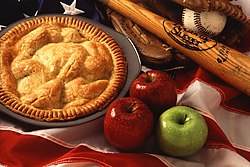
| Part of a series on the |
| Culture of California |
|---|
 |
| California Portal |
| Part of a series on |
| American cuisine |
|---|
 |
California cuisine is a food movement that originated in Northern California, in the United States. The cuisine focuses on dishes that use local and sustainable ingredients, with attention to seasonality. [1] [2]
Contents
The food is historically chef-driven; Alice Waters's restaurant Chez Panisse is an iconic example. Dishes and meals low in saturated fats and high in fresh vegetables and fruits with lean meats and seafood from the California coast often define the style.
The term "California cuisine" arose as a result of culinary movements in the last decades of the 20th century and is not to be confused with the traditional foods of California. California fusion cuisine has been influenced by French, American, Italian, Mexican, and culinary styles, among other food cultures.